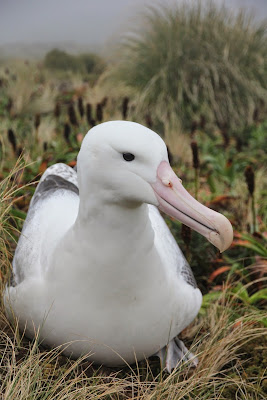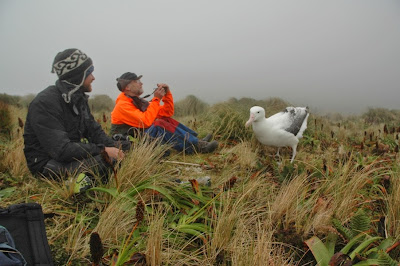12 February 2014
Low early morning fog prevented the fittest of us from trekking up Mount Honey, Campbell Islands highest peak so instead we joined the zodiac cruise to the 3 different bays to some the Campbell island shag, teal, Antarctic terns, giant petrel, and sealions.
I had an unbelievably special afternoon. I followed the boardwalk up through the low fog to the hilltop breeding sites of the southern royal albatross. I was first up the track and say a baby newborn chick under its mother which was a special sight.
Our group had a permit to get off the track and observe albatross up close so I sat amongst the fog on the hill watching albatrosses fly around and I even say one take off and another land.
The one that landed walked over to a nest and the birds were being very vocal so I came over for a closer look and ended up spending a couple of hours observing. They groomed each other and the female got off the nest which revealed a large egg that was STARTING TO HATCH. The male then took over incubating the egg from its partner and the female came across to me all curious and peaked at my shoes before walking up the hill and taking off. This is the first time I have seen a pair together and I felt very privileged to see these interactions especially that chick hatching.
A few of the other passengers saw snipe and yellow eyed penguins along the track.
With low fog continued to be forecast it was decided to leave Campbell Island for the Snares missing the chance to see the Campbell Island albatross and rockhopper penguins nesting on the northern coast of the island. Have to take the good with the bad as this afternoon made up for it.
The Chefs gave Greg and I a tour of the kitchen and food store rooms. There were over three levels right to the bottom of the ship and lifts to get the food up to the kitchen. It was interesting to see how it all worked and how even a month after we left that we were still getting crisp green lettuce salads.
THOUGHTS ABOUT SUB ANTARCTIC ISLAND MANAGEMENT
It is so great to see what the removal of sheep, rats and other pests has done to this island. Wildlife is thriving and plant life is growing strongly and everyone involved in these programs has done a really good job. In saying that though I think this is the type of island that should be less restrictive in terms of visitor landings. It would be great to see proper permanent tracks cut and allow more people to experience this unique area to see what pest eraditication can do on such a big scale while at the same time not impacting on the environment. I think restricting islands like this as much as the New Zealand government has is not fair where you need to be in the know e.g. have to be a researcher to actually land here (like what happens with many other islands that DOC governs).
Conservation is so important but its all about getting ordinary person involved through experiencing these special places so they can advocate for their preservation.
Antarctica also needs to be less restrictive for the same reason. I don’t want to see big cruise ships coming to the sub-antarctics or into the Ross Sea and I believe boats should have a government reps to make sure rules are followed but I think operators need to have more freedom to experience these places fully.
Zodiac cruise of Perserverance Harbour and bays
The sealions were very curious and kept following the boats I think they were interested in the bubbles made by the propellers.
Antarctic tern
A giant petrel making the most of a freshly dead seal
Campbell Island Shag
The guiness world records loneliest tree.
This female sealion was very curious coming up close to everyone, biting bags.
Campbell Island Royal Albatross nesting area
Kevin leading the way along the boardwalk through the fragile vegetation
It was great to see so many pipits throughout the island. They are very friendly birds that walk 1 metre in front of you. I saw a mother feeding its baby a berry which was neat.
Pleurophyllum species
Neat flower in the fragile peat
Royal albatross with its newly born chick.
Nesting royal visible through the heavy fog
It was very special to see this royal albatross take off into the wind.
I observed these two albatross for hours as they hung out and groomed each other
The nesting albatross revealed egg which was actually hatching. If you look close you can see the eye of the unborn chick.
One of the birds took over from the other with incubating the egg
The albatross that had been nesting started stretching its wings after having been on the nest so long
It then came right up to me for a closer look
It then walked up the Hill and took off into the wind
Housing for researches that stay on the island





























No comments:
Post a Comment